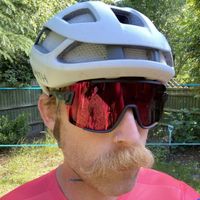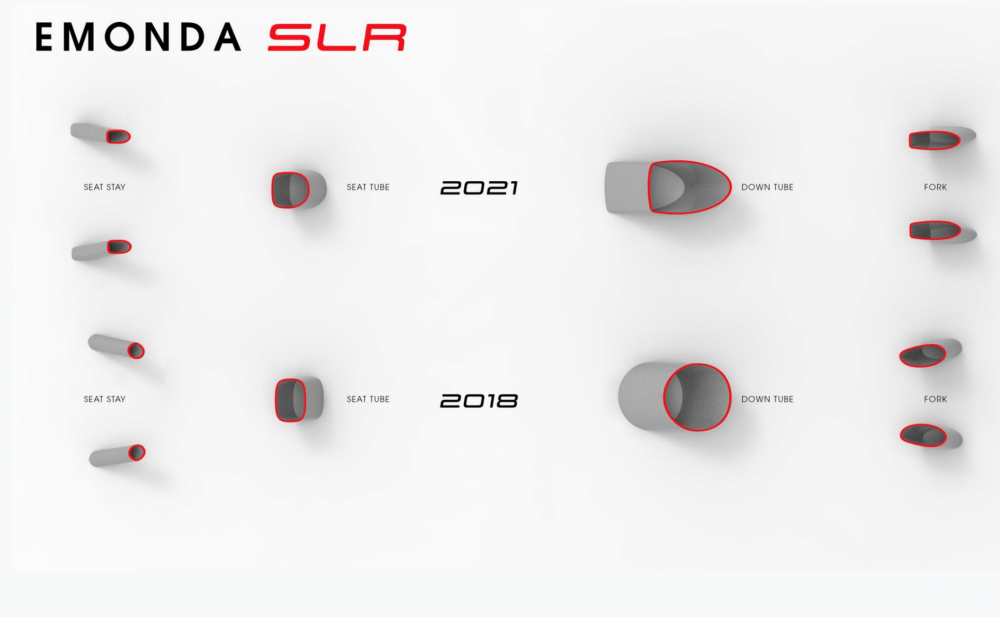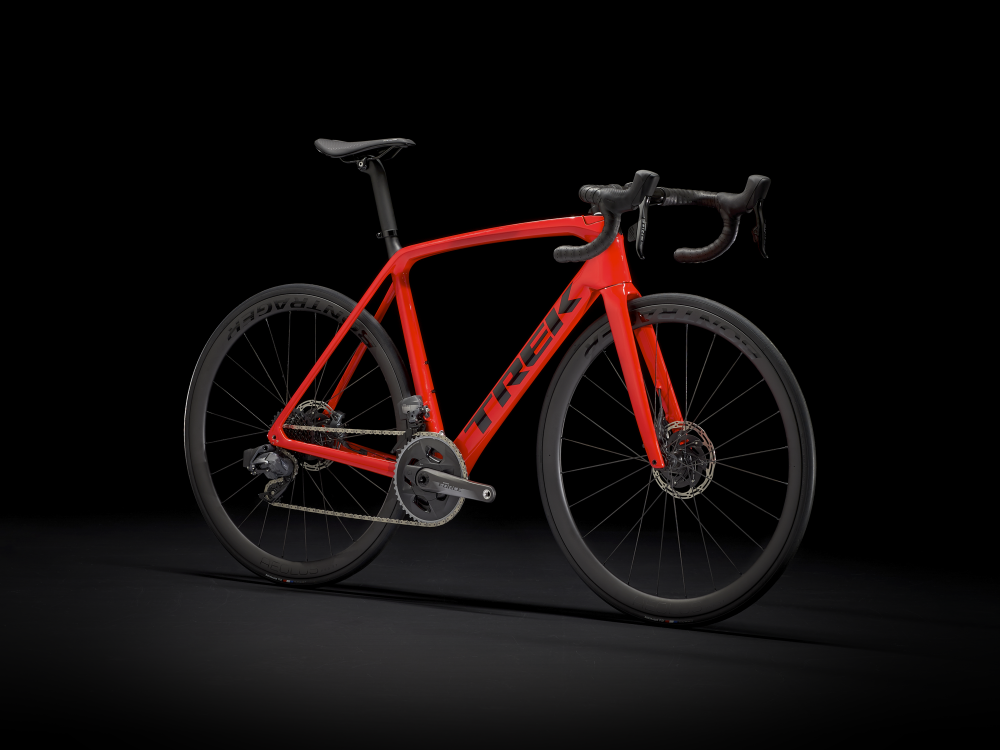Trek’s updated Émonda aims to be the fastest up Alpe D’Huez
Trek claim the new Émonda is the fastest climbing bike it has ever produced


Trek has updated its Émonda lightweight race bike, with the aim of making it the fastest bike to climb the Alpe D’Huez.
In pursuit of this goal, it’s focused attention on improving the machine’s aerodynamics over dropping weight.
The Émonda was first launched in 2014, and the goal was to build the lightest production road bike in the world. But the brand added a caveat – it needed to provide a ride quality that had none of the usual skittish, unstable and unbalanced characteristics usually associated with über lightweight bikes.
When it first launched, the top level SLR 10 tipped the scales at a paltry 4.6kg, light enough to claim the coveted ‘lightest stock road bike in the world’ prize, with a size 56 frame weighing 690g.
A buyer's guide to Trek road bikes 2020, which is right for you?
A further update in 2018 saw the Émonda incorporate disc brakes yet manage to drop the frame weight to a crazy light 665 grams, thanks to embracing advancements in carbon fibre and new computer-aided design practices.

Now the Émonda has been reimagined again. For the third edition, Trek went back to the drawing board. Because you see, being the lightest doesn’t necessarily mean you’re going to be the fastest to the top of the climb– and Trek wanted the Émonda to climb faster than any other lightweight race bike in existence.
The latest race content, interviews, features, reviews and expert buying guides, direct to your inbox!
The fastest climbing bike ever
So it set another challenge - to be the fastest bike to climb the iconic Alpe D’Huez. Achieving this goal isn’t all about weight, reducing drag is also a major factor. So the team behind the Émonda experimented with adding weight to the frame in the form of shapes that would reduce drag and then working out the balance point between increased weight versus reduced drag.

The new Émonda features a completely new set of tube shapes, most of which have gone down the aero route. But Trek is at pains to keep the comparisons to the Madone aero race bike to a minimum; this isn’t simple a ‘Madone Lite’. Rather than being the same elongated shapes as found on a proper aero race bike, the aero shaping of the Emonda’s tubes is much more subtle and is based around the principle of unsteady aerodynamics.
In this case it’s more about how drag is affected through wind gusts and other factors at slower speeds than the usual 45km/h, after all, not even pros climb at these speeds. There are still the characteristic truncated airfoil shapes that we associate with aero frames but the effect is far less dramatic and produces a frame that still has a traditional look.
Trek hasn’t jumped on the dropped seatstay bandwagon with the new frame either, preferring to stick to a set of widely spaced yet aero shaped, thin seat stays.

So how fast is the new frame? Putting it into simpler terms – the brand claims it is a whole minute per hour faster on a flat course at 350 watts and 18 seconds faster on a gradient of 8.1% (the average gradient of the Alpe).
Trek hasn’t been shy about making direct comparisons to competitors, either – claiming that the new Emonda would be 13 seconds faster on the same climb than the Specialized S-Works Tarmac. That’s fighting talk.
But despite the fact that aero shaping inherently results in tubes that are heavier than traditional round tubes, the top level Emonda SLR still remains true to the original remit of achieving a sub 700 gram frame, with the new frame weighing in at a similar weight to the original Émonda frame.
It’s managed this through the use of Trek’s all-new proprietary OCLV 800 carbon fibre. OCLV 800 is apparently 30 per cent stronger than the previous ‘best’ OCLV 700, which means Trek can get away with using less carbon without losing strength and the classic Émonda ride quality.
For comparisons sake, if Trek tried making the new frame out of OCLV 700 it would weigh in at about 60 grams heavier.

The new frame also enjoys a little more integration, bringing it more in-line with the Madone. All models now see the cable routing brought neatly into the frame at the front of the headtube keeping the front end profile as slippery as possible.
Split spacers make adjusting the bar height a much simpler task. Top end SLR models will also feature a new Bontrager Aeolus RSL integrated carbon bar and stem featuring the same aero shaping and a neat semi-integrated cable routing to further neaten the front end.
The other notable feature of the new frame is a wholesale move to the T47 bottom bracket standard. This style marries the reliability of a threaded shell with the capability of running larger diameter internal bearings and enables Trek to maintain its characteristic wide and efficient bottom bracket stance.

The new Émonda range has also been designed with Trek’s middle-ground H1.5 geometry ensuring a set of numbers that sits it half way between the ultra-aggressive pro H1 and its laid back and relaxed, endurance specific H2 geometry.
And finally, keeping the Émonda in a pretty rigid user set Trek has bucked another trend and limited tyre clearance to just 28c putting the focus of the bike purely on high performance.
It's also interesting to note that the Émonda will only be available in a disc brake version, no plans are in place to release (a potentially lighter) rim brake model.
The full Émonda range

Trek are releasing ten complete Émonda models plus two frameset options split into two ranges, SL and SLR. The SLR range features the lightest OCLV 800 frame weighing sub 700 grams whilst the SL features the identical frame design and aero benefits but utilises a more economical (and heavier) OCLV 500 frame material.
Trek Émonda SLR 9 Etap £9,700
- OCLV 800 carbon frame and fork
- SRAM Red eTap AXS groupset
- Bontrager Aeolus RSL 37 carbon wheels, Bontrager R4 320 tyres
- Bontrager Aeolus RSL integrated bar/stem
- Weight: 6.75kg (14.88lbs)
Trek Émonda SLR 9 £9,700
- OCLV 800 carbon frame and fork
- Shimano Dura Ace Di2 R9170 groupset
- Bontrager Aeolus RSL 37 carbon wheels, Bontrager R4 320 tyres
- Bontrager Aeolus RSL integrated bar/stem
- Weight: 6.78kg (14.95lbs)
Trek Émonda SLR 7 Etap £6,850
- OCLV 800 carbon frame and fork
- SRAM Force eTap AXS groupset
- Bontrager Aeolus Pro 37 carbon wheels, Bontrager R3 tyres
- Bontrager Aeolus RSL integrated bar/stem
- Weight: 7.35kg (16.2lbs)
Trek Émonda SLR 7 £5,900

- OCLV 800 carbon frame and fork
- Shimano Ultegra Di2 R8070 groupset
- Bontrager Aeolus Pro 37 carbon wheels, Bontrager R3 tyres
- Bontrager Aeolus RSL integrated bar/stem
- Weight: 7.17kg (15.8lbs)
Trek Émonda SLR 6 £5,450
- OCLV 800 carbon frame and fork
- Shimano Ultegra R8000 groupset
- Bontrager Aeolus Pro 37 carbon wheels, Bontrager R3 tyres
- Bontrager Aeolus RSL integrated bar/stem
- Weight: 7.26kg (16lbs)
Trek Émonda SL 7 eTap £5,250

- OCLV 500 carbon frame and fork
- SRAM Force eTap AXS groupset
- Bontrager Aeolus Pro 37 carbon wheels, Bontrager R2 tyres
- Bontrager Pro VR-C carbon handlebar, Bontrager Pro stem
- Weight: 7.94kg (17.5lbs)
Trek Émonda SL 7 £4,850

- OCLV 500 carbon frame and fork
- Shimano Ultegra Di2 R8070 groupset
- Bontrager Aeolus Pro 37 carbon wheels, Bontrager R2 tyres
- Bontrager Pro VR-C carbon handlebar, Bontrager Pro stem
- Weight: 7.76kg (17.1lbs)
Trek Émonda SL 6 Pro £3,350

- OCLV 500 carbon frame and fork
- Shimano Ultegra R8000 groupset
- Bontrager Aeolus Elite 35 carbon wheels, Bontrager R2 tyres
- Bontrager Elite VR-C alloy handlebar, Bontrager Pro stem
- Weight: 8.06kg (17.78lbs)
Trek Émonda SL 6 £2,900

- OCLV 500 carbon frame and fork
- Shimano Ultegra R8000 groupset
- Bontrager Paradigm Disc alloy wheels, Bontrager R2 tyres
- Bontrager Elite VR-C alloy handlebar, Bontrager Pro stem
- Weight: 8.28kg (18.25lbs)
Trek Émonda SL 5 £2,275

- OCLV 500 carbon frame and fork
- Shimano 105 R8000 groupset
- Bontrager Affinity Disc alloy wheels, Bontrager R1 tyres
- Bontrager Comp VR-C alloy handlebar, Bontrager Elite stem
- Weight: 9.16kg (20.2lbs)
First ride impressions
Trek has kindly sent in a SL 6 Pro, Ultegra equipped Émonda for me to test and whilst it's not the all-singing SLR version it has enough of the DNA of that ultra-light package to really get to grips with what this new platform can deliver.
From the first press of the pedals this new Émonda shares the same tight (read stiff) energy that the existing version is endowed with. Pushing up to speed and it's clear that this bike is all about efficiency without compromise. Yes, it's not as easy to maintain the seriously rapid progress you can achieve on a Madone but it now gives it a real run for its money and as to be expected, as soon as you stamp up a climb it skips away with a gloriously lively spring in its step. What is to be noted is that the straight seat stays, 25mm tyres and stiff bottom bracket make for a slightly chattery ride on rougher roads, despite the claimed comfort the integrated/upside down seat post supposedly brings. But what you cannot deny is how well this bike just eats up the miles and a raft of PRs on its maiden voyage testifies to the performance values of this new machine.
Expect a full review of the Trek Émonda SL 6 Pro to follow in the next few weeks.
James Bracey's career has seen him move from geography teacher, to MBR writer, to Cycling Weekly's senior tech writer and video presenter. He possesses an in-depth knowledge of bicycle mechanics, as well as bike fit and coaching qualifications. Bracey enjoys all manner of cycling, from road to gravel and mountain biking.
